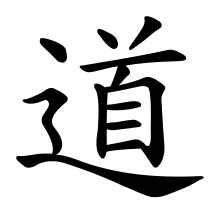Fulu
Fulu (simplified Chinese: 符箓; traditional Chinese: 符籙), is a term for supernatural Taoist incantations and magic symbols as a Chinese incantation[1][2][3] or (written or painted) charm or a Chinese talisman as a Lingfu (simplified Chinese: 灵符; traditional Chinese: 靈符)[4] [5][6] by Taoist practitioners in the past,
- Fu (Chinese: 符),[7] Shenfu (Chinese: 神符) which they believed functioned as summons or instructions to deities, spirits, or as tools of exorcism,[8] as medicinal potions for ailments. It is believed by Taoists that in the past the ability to write Shenfu had been once decreed by their deities to authorized priests or daoshi.
- Lu (Chinese: 籙) is a register and compilation of the membership of the daoshi as well as the skills they were able to use.
| Part of a series on |
| Taoism |
|---|
 |
|
Practices
|
|
Deities |
|
Organisations |
These practitioners are also called Fulu Pai (Chinese: 符籙派) or the Fulu Sect made up of daoshi from different schools or offshoots of Taojia.
Names
Different names for Fulu in English include Daoist magic writing, Daoist magic script characters, Daoist magic figures, Daoist magic formulas, Daoist secret talismanic writing, and talismanic characters.[9]
General design
Fu symbols tend to have twisted strokes that sometimes resemble Traditional Chinese characters.[9] Only Daoist priests can write, read, and understand this "magic" writing system and the characters can differ from Daoist sect to Daoist sect.[9] The method of writing down these characters is passed down secretly from Daoist master to their disciples.[9] According to these Daoist sects if "magic" writing were easy to understand then anyone could have the power to control the spirits.[9]
Some "magic" Fu script characters appear to have been formed by stacking one Traditional Chinese character atop of another Traditional Chinese character and then making these different characters into a single character.[9] This specific technique of linking or combining different Chinese characters was not used exclusively by the Daoists, however, Fu characters also appear on other types of Chinese charms such as Buddhist coin charms and woodblock print charms.[9]
Daoist scripture
One of the earliest classical scripture referring to Fu was the Huangdi Yinfujing (Chinese: 黃帝陰符經), although it does not contain specific instructions to write any talisman.
The second chapter of each of the three grottoes in the Daozang is a record of the history and feats of the Fulu Sect, where it is described that the origin of Fu script is from the condensation of clouds in the sky.[9]
Fu on Taoist talismanic coins
.jpg)
Fu script was also used on Taoist coin talismans (many of which resemble cash coins), many of these talismans haven't been deciphered yet but a specimen where Fu was used next to what is believed to be their equivalent Chinese characters exists.[9][10][11] On rare occasions Taoist Fu writing has also been found on Buddhist numismatic charms and amulets. Most of these coin talismans that feature Fu writings request Lei Gong to protect its carriers from evil spirits and misfortune.[9]
Fulu characters are usually included at the beginning and the end of the inscription of a Taoist coin charm.[9]
See also
References
- "符籙". Ninchanese. Retrieved 11 September 2019.
- "符籙". Ninchanese. Retrieved 11 September 2019.
- "符籙". ApproaChinese. Retrieved 11 September 2019.
- "灵符". Ninchanese. Retrieved 11 September 2019.
- "灵符". Ninchanese. Retrieved 11 September 2019.
- "灵符". ApproaChinese. Retrieved 11 September 2019.
- "Amulettes religieuses (Religious charms)". François Thierry de Crussol (TransAsiart) (in French). 14 September 2015. Retrieved 6 July 2018.
- The Tao of Craft: Fu Talismans and Casting Sigils in the Eastern Esoteric Tradition by Benenell Wen. Publisher: North Atlantic Books. Publication date: September 27, 2016. ISBN 978-1623170660.
- "Daoist (Taoist) Charms - 道教品壓生錢 - Introduction and History of Daoist Charms". Gary Ashkenazy / גארי אשכנזי (Primaltrek – a journey through Chinese culture). 16 November 2016. Retrieved 10 May 2018.
- TAOISTSECRET.COM Taoist Talismans. Retrieved: 10 May 2018.
- Anything Anywhere - CHINA, amulets. Chinese culture is permeated, no, based on poetic allusion, hidden meanings, union of opposites, complex currents of energy and intention. In certain contexts these bases can express in rank superstition (present in all human cultures), and in others can lead to scientific advancement. Retrieved: 10 May 2018.
External links
